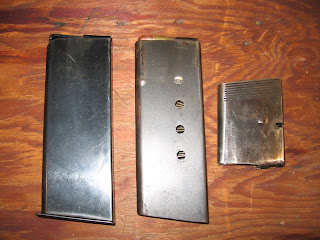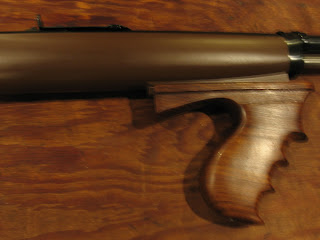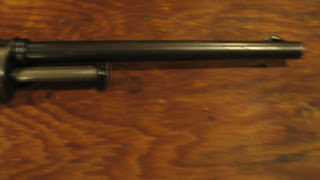If you have seen AMC’s new series “The Son” you’ll notice the real start of the show, the Winchester Model 1907 rifle with a 10 shot magazine. In the early 20th century, the Winchester Model 1907 rifle in 351 Winchester caliber was a formidable weapon for close range combat. Originally designed for hunters in thick vegetation, the 351 Winchester Model 1907 rifle soon found a niche as a self- defense arm. The availability of 10 shot magazines increased the rifle’s firepower which easily outclassed the traditional lever action rifles of the period.
 |
| Two Winchester Model 1907 rifles, The Lebman Model (top) and the standard model (below). |
The traditional lever action rifle chambered in in revolver cartridges like the 38-40, and 44-40 are excellent fighting rifles. However, the Model 1907 with preloaded magazines is quicker to reload, and the 351 Winchester cartridge is superior in range and stopping power to the older rimmed revolver rounds. In fact, the 351 Winchester significantly out performs the more modern 357 magnum with the same weight bullets and barrel lengths. In ballistic gelatin tests under 50 yards, the 351 Winchester outperforms the 5.56 NATO. Beyond 50 yards the 35 caliber round nose bullet decelerates considerably.
The US Army, French, British, and Russian armies used in very limited numbers the Winchester Model 1907 during the First World War era. The rifle was also a favorite of outlaws and law enforcement during the 1920s and 1930s. The vast majority, perhaps 99% of the rifles used on both sides of the law were standard rifles off of store shelves. In the late 1930s, Winchester developed a police variant with a heavier stock and sling swivels for the law enforcement market.
 |
| French Army motorcycle messenger armed with a Winchester Model 1907 in WW I. |
One of the more interesting variants, which number no more than six to ten original examples are the “Lebman 1907 Winchester” rifles. “Gunsmith to the Gangsters” Hyman S. Lebman equipped these rifles with an aluminum handguard which mounted a Thompson vertical fore-grip, 10 shot magazine, and a compensator of his own design. Lebman converted at least some rifles to fully automatic fire.
 |
| The Lebman Model 1907, only about 6 of these rifles were made but they were in the hands of Pretty Boy Floyd, Baby Face Nelson, and Homer Van meter. They can be custom built today for collectors. |
Shooting both a Lebman and standard Winchester Model 1907 rifle is a trip back in time. One surprising trait of both rifles is how heavy they feel for their size. The large counter weight under the forearm contributes to the rifle’s heft. The weight and power of the rifle inspire confidence and helped the rifle’s popularity.
While the 1907 does not have the magazine capacity of the far more famous Thompson SMG, it is a rifle which can make quick hits out to 100 yards. Law enforcement used the Model 1907 very heavily in the 1930s. The FBI used a small number of Model 1907 rifles until about 1950. One of the largest users of Model 1907 rifles were several state prison systems. The range and firepower of the Model 1907 were ideal for prison guards. The Ruger Mini-14 replaced the last Model 1907s in service during the early 1970s.
 |
| After market 10 round, 1930s police 10 round, and standard 5 round magazines. |
For modern shooters, the Winchester Model 1907 is an elusive pleasure. This early semi-automatic suffers from a lack of factory loaded ammunition and hand loading components. This is obviously due to low demand. Unfortunately low demand is very different from no demand. There are many thousands of Winchester 1907s languishing in gun racks simply in need of ammunition. Fortunately, Captech International (formerly Jamison) manufactures occasional runs of .351 Winchester brass. Graf & Sons sells excellent quality .351 diameter 180 gr bullets. This brass and bullet combination on top of an 18 gr charge of IMR 4227 will get a Model 1907 shooting. This load is quite accurate and should perform well on targets or game. It would be nice if JHPs were available to hand loaders for higher performance loads.
Another dogging issue is the availability of replacement magazines. Currently offered aftermarket magazines are not as reliable or as well made as the original OEM magazines or the period police style 10 round magazines. On the aftermarket mags, they usually need the feed lips adjusted and the magazine follower trimmed to function properly.
 |
| The follower must not interfere with the magazine catch notch or the rifle will jam. the right leg of the follower must usually be trimmed on aftermarket magazines. |
There are several issues with Winchester Model 1907s today. First is most examples have a cracked wooden forearm. The walnut factory stocks were thin and somewhat frail to begin with. Sometimes nearly 100 years of use or neglect has resulted in cracks, sometimes running the length of the forearm. The action of the large counter under the forearm and improper disassembly procedures also contribute to these cracks. Repaired stocks will last, but will almost inevitably crack again in the same place. Lebman solved the cracked forearm problem with a painted aluminum forearm which also mounted a Thompson style vertical fore grip.
 |
| The aluminum forearm and Thompson style vertical grip on a Lebman model 1907 |
Second, the chambers of these guns are usually fouled or even pitted. If a rifle is exhibiting difficult extraction, thoroughly cleaning and even polishing the chamber with JB Bore brite will help immensely. Third, the rifle should be checked by a good gunsmith and have the recoil buffer checked and the trigger assembly inspected. These rifles have difficult trigger pulls which take some getting used to. However, they should be inspected to insure proper operation. The recoil buffers dry our and wear out and should be replaced, especially the early ones which may be 110 years old.
 |
| Lebman recoil brake on a 16 inch barrel. |
These rifles and the .351 cartridges are ideal for whitetail deer sized game at 100 yards or closer. Although heavy for it’s size the rifle is fast handling and given the trigger and sights, quite accurate. Offhand 3 shot groups at 25 yards consistently have all 3 shots holes touching.
 |
| Winchester model 1907 standard 20 inch factory barrel. |
The Winchester Model 1907 is an overlooked but historically important part of firearms history. It is a rewarding rifle to shoot, but it can present some obstacles in terms of ammunition and magazines.

.gif)
.gif)
.png)
.jpg)
.jpg)
.gif)
.jpg)
.gif)



